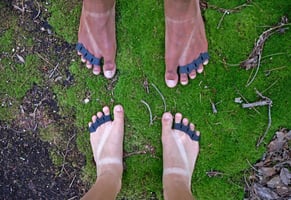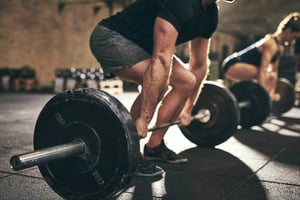As a performance physical therapist in Wilmington, NC, I often get asked, "Should I be using...
The Foot Tripod
Foot Tripod: The Foundation of Stability and Movement
When it comes to physical therapy, few concepts are as foundational to movement and balance as the foot tripod. This biomechanical principle plays a critical role in foot positioning, stability, and even the engagement of muscles higher up the kinetic chain, including the glutes. In this blog, we’ll explore what the foot tripod is, why it’s essential, and how mastering it can enhance overall performance and reduce injury risk.
What is the Foot Tripod?
The foot tripod refers to three key points of contact on the bottom of your foot that create a stable base for movement:
- The base of the big toe (first metatarsal head)
- The base of the pinky toe (fifth metatarsal head)
- The heel (calcaneus)
Imagine these three points forming a triangle. When these points are evenly engaged with the ground, the foot achieves optimal stability, allowing for efficient weight distribution and movement. This alignment is vital for maintaining balance and supporting the rest of the body and placing stress on the proper muscles, joints and connective tissue while preventing unnecessary strain on the surrounding areas.
Here is a photo of the foot tripod and weight distribution when performing a squat. While standing, the majority of our body weight should fall through the center of the foot tripod.
Why is the Foot Tripod Important?
- Promotes Proper Foot Positioning
The tripod ensures that the foot is not excessively pronated (rolling inward) or supinated (rolling outward). Improper foot alignment can lead to a cascade of issues, including ankle instability, knee pain, and even hip or lower back discomfort. - Enhances Stability
By maintaining contact through the tripod points, the foot creates a stable foundation for movement. This stability is crucial for activities ranging from walking to high-impact sports like Olympic Weightlifting. When we start to train the foot tripod, we do so in static movements such as a squat. By building stability in those patterns, we can then progress to more dynamic movements such as running and retain the stability we gained from those static positions as well as be more likely to maintain proper foot positioning during those more dynamic movements. - Supports Glute Engagement
A well-aligned foot tripod encourages proper alignment of the entire lower extremity. When the foot is stable with our body weight evenly distributed over those points, our knees and hips are placed in an optimal position, allowing muscles like the glutes to activate effectively. Poor foot positioning often leads to compensations that reduce glute engagement and increase reliance on smaller, less powerful muscles. (More on how the foot position can influence the glutes later in this blog). - Improves Balance and Coordination
Whether you’re performing a single-leg balance exercise or a heavy squat, the foot tripod plays a key role in maintaining balance and symmetry. It helps the body sense where it is in space (proprioception) and adapt to dynamic movements without a loss of balance or positioning. The more contact we have with the ground in an evenly distributed weight bearing position (our weight centered in the middle of the triangle of the foot tripod), the better our balance and proprioception will be. If we lose contact with one of those tripod points, that immediately decreases our brain's ability to perceive where the body is in the environment.
Reduces Risk of Injury
A solid tripod reduces excessive stress on any one part of the foot, knees or hips. This balanced load distribution helps prevent overuse injuries in the entire lower extremity. Oftentimes, we see knee pain and hip pain due to poor positioning of the foot resulting in overloading the knees or hips.
How to Assess and Strengthen Your Foot Tripod
Assessing Your Tripod- Stand barefoot on a firm surface.
- Check if you can feel even pressure across all three points (big toe, pinky toe, and heel) with your bodyweight going through the center of that triangle.
- If one area feels lifted or overly compressed, you may have an imbalance.
Exercises to Strengthen the Foot Tripod
-
- Toe Yoga: Lift and spread your toes, then press them into the ground while maintaining contact at all three tripod points. Try keeping the big toe pressed down into the floor while lifting all of the other toes, then press those other toes down while lifting the big toe. Then alternate between these two movements while trying not to lose the tripod contact points!
- Short Foot Exercise: Gently pull the ball of your foot toward your heel without curling your toes to strengthen the arch.
- Single-Leg Balance Drills: Stand on one foot, ensuring even pressure on the tripod points, to improve stability.
Here are two of our favorite exercises to start building up that foot tripod and strengthening those intrinsic foot musculature through use of the short foot position!
Incorporate Foot Awareness Into Movement
During activities like squats, lunges, step ups and Romanian deadlifts, consciously engage your foot tripod. Feel the connection between your feet and the ground, and notice how it improves your alignment, stability and power. We like to cue “screwing the foot out” against the ground without actually moving the foot out (this creates that torque and engagement we discussed) to achieve the tripod position in standing before beginning movement. Helpful cue: If you find yourself losing the middle two tripod points (ball of the big toe and inside of the heel) when attempting to “screw out”, try placing all of your bodyweight onto those middle two tripod points and then offweighting them slowly as you place equal weight onto the outside tripod point (ball of the little toe), now you should have equal weight between all three points!
Connecting the Foot to the Whole Body
At Conquer Movement, we emphasize the importance of the glutes for entire lower body stability and injury prevention. Not only does the foot tripod increase stability, but also influences the ability of your glutes to engage, along with the angle of turnout of your foot. To understand the ability of foot position to influence the glute I will briefly dive into active and passive insufficiency. Active insufficiency is when a muscle is too shortened to be able to contract at its maximal potential because the muscle fibers (actin and myosin) are overlapping too much and cannot grab onto each other, passive insufficiency is when a muscle is too lengthened to be able to contract at its maximal potential because the muscle fibers are too stretched and too far apart to grab onto each other. Now, to understand why the degree of foot turn out may influence the glutes, we need to understand that one of the roles of the side glute (gluteus medius) is to externally rotate the entire leg, or hip. When we externally rotate our hip by turning our foot out too much, we place the side glutes into a shortened position and create active insufficiency. Ideally, we have them in a neutral position so they can contract and have their fibers grab onto each other easily.
Big Takeaway: The anatomy component of the foot tripod is complicated and can be difficult to conceptualize. The big takeaway should be that the foot tripod isn’t just about the foot; it’s about how the entire body moves and functions. When your feet are stable and properly aligned, they create a domino effect of improved mechanics throughout your legs, hips, and core. For athletes and active individuals, this translates to better performance and fewer injuries.
The image below illustrates how foot position is crucial for the positioning of the surrounding areas!
Barefoot Training and Proper Footwear
If you watch any of our Physical Therapists or our patients in the gym, you will likely see them training barefoot (this can mean actually barefoot or just in socks) or in barefoot shoes. This is optimal for contact between the foot tripod and the floor. One of our favorite shoes to wear are vivobarefoot shoes, their website is also a fantastic resource for understanding the importance of a shoe that mimics our barefoot state.
How a Proper Foot Tripod Position Can Increase Intrinsic Foot Muscle Strength and Benefit Runners
The concept of the foot tripod is integral to understanding how optimal foot alignment can enhance performance and prevent injuries. The intrinsic foot muscles, located entirely within the foot, play a pivotal role in providing stability, supporting the arch, and enhancing overall balance. These muscles include the flexor digitorum brevis, abductor hallucis, and plantar interossei, among others. When the foot tripod position is maintained, these muscles are engaged more effectively. Over time, this consistent engagement strengthens the intrinsic foot muscles, improving their endurance and function. As mentioned earlier, even static strengthening of the intrinsic foot musculature has application to running form and performance.
For runners, strong intrinsic foot muscles are invaluable. These muscles act as shock absorbers, reducing the impact on joints during repetitive pounding on hard surfaces. Additionally, they help maintain proper alignment of the foot and ankle, which minimizes the risk of common running injuries like plantar fasciitis, shin splints, and Achilles tendinopathy (and even injuries higher up the chain such as knee, hip and low back injuries related to running). A stable and aligned foot also ensures better propulsion during the push-off phase, allowing runners to move more efficiently.
By committing to exercises and practices that reinforce the foot tripod position, runners not only strengthen their intrinsic foot muscles but also build a more resilient and efficient foundation for their sport. This small yet significant adjustment can lead to improved performance and reduced injury risk, making it a fundamental aspect of any runner’s training regimen.
How a Proper Foot Tripod Position Can Enhance Glute Power for Weightlifters
While the foot tripod is often associated with runners, its importance extends far beyond running. For weightlifters, maintaining a proper foot tripod position can dramatically enhance power output from the glutes (for the reasons mentioned earlier), leading to improved performance in lifts like squats, deadlifts, snatches and clean and jerks. This connection is rooted in biomechanics and the role the foot plays as the foundation of the kinetic chain which is something that exists in every athlete, not just runners.
The gluteal muscles (comprising the gluteus maximus, medius, and minimus) are among the most powerful muscles in the body and extremely important in any weightlifting related sports. They play a key role in hip extension, abduction, internal rotation, external rotation, and overall stabilization during weightlifting movements. As mentioned earlier, the efficiency of the glutes depends on the stability of the lower extremities, starting with the feet. When the foot tripod position is correctly maintained, the weight is evenly distributed across the three points, creating a stable base from which the glutes can generate maximum force.
One of the main benefits of a proper foot tripod position for weightlifters is the improvement in ground force reaction. The more stable the foot, the better the transfer of force from the ground through the legs and into the glutes. This is especially important during compound movements like squats and deadlifts, where any imbalance in foot positioning can lead to energy leaks, reducing overall power output and increasing the risk of injury. Think of the kinked hose analogy we have talked about for nerves except now it is a loss of energy due to kinks in the system.
Additionally, maintaining a foot tripod position promotes proper alignment of the knees and hips. When the foot is stable, the knees track more effectively over the toes, and the hips remain in an optimal position to recruit the glutes. This alignment is particularly crucial during heavy lifts, where even minor deviations can compromise form and limit strength gains. Every weightlifter, even the pros, could benefit from improvements in positioning as they will likely help them lift heavier weights with more ease and less potential risk of injury.
Weightlifters can incorporate specific drills to ensure they maintain a foot tripod position during their lifts. Exercises such as barefoot squats or hinging with the linked resistance band drills that emphasize proper foot positioning. This can help reinforce proper knee tracking and glute engagement even when the band is taken away. Once the band is taken away, practicing all lifts with a focus on grounding the three points of the foot can improve proprioception and ensure that the glutes are fully engaged without the need for an external cue such as the band.
Another key advantage of a proper foot tripod position is the enhancement of stability during explosive movements like cleans and snatches. These Olympic lifts require precise coordination and maximal power output. A stable foot tripod ensures that the lifter can generate explosive force from the glutes without sacrificing balance or risking injury.
By focusing on the foot tripod, weightlifters can unlock the full potential of their glutes, leading to more efficient lifts and greater strength gains. This foundation not only enhances performance but also reduces the risk of common weightlifting injuries, such as knee pain, hip pain, and lower back/nerve aggravation. Whether you’re a seasoned lifter or just starting, mastering the foot tripod position is an essential step toward achieving your strength and power goals.
Start from the Ground Up at a Performance Based Physical Therapy Clinic
At our performance-based physical therapy clinic, we emphasize the importance of foundational concepts like the foot tripod. Whether you’re recovering from an injury, looking to improve your athletic performance, or seeking to enhance your daily movement, mastering the tripod is a critical step toward reaching your goals. Conquer Movement Physical Therapy is the place to go to build a more stable base and foundation as an athlete. We can help you find your ideal foot tripod and short foot positioning! Schedule a free discovery call with one of our Doctors of Physical Therapy to start building bulletproof feet!
Best,
Dr. Kylie Miller PT, DPT






Leave A Comment: